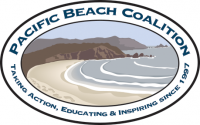Every fourth Saturday of the month, father and son, Jeff and Paxton Christner, participate in the monthly Mussel Rock cleanup. The two Pacificans began picking up trash at Mussel Rock in 2007, the year Paxton turned eight.
“We started out doing the annual Pacific Beach Coalition (PBC) Earth Day and Coastal Cleanup Day as a fun father/son activity,” said Jeff, a Humane Officer with the Peninsula Humane Society & SPCA. “We picked Mussel Rock since I felt at the time that the more common locations, like Linda Mar, would have more people and therefore less stuff per person would be picked up.”
Jeff was also aware that the riprap along the seawall at Mussel Rock acts as a marine debris trap, perhaps attracting “cooler things to find.”
Paxton, now 16, and a junior at Oceana High School, notes that finds over the years have included: the end piece of an 80-pound concrete pumper, countless fishing ropes and netting, buoys, tires, bait containers, fishing filters, Styrofoam, crab pots, and enough syringes and needles to warrant his dad keeping a medical Sharps bin on hand.
“On July 25, 2015, just north of Mussel Rock, on the rocks/riprap seawall of the old dump, Paxton and I found a green fish crate,” Jeff said of the suspected Japan Tsunami Marine Debris (JTMD) find. “We hauled the crate and everything else we found that day back up to the parking lot (a 1/ 2 mile, 200-foot elevation climb), to Helen Nicely, the PBC site captain. She photographed it and notified the NOAA (National Oceanic and Atmospheric Administration) about the discovery.
The NOAA has established official protocol and guidelines for identifying JTMD. The debris is the result of the March 11, 2011, magnitude-9.0 earthquake that shook northeastern Japan for six minutes. The earthquake triggered a tsunami with waves up to 130 feet that devastated over 200 miles of land, left 6,000 injured, claimed 16,000 lives, caused a level 7 nuclear meltdown in the Fukushima Daiichi Nuclear Power Plant, and four years later, still has 230,000 people living in temporary housing. According to the NOAA, approximately 5 million tons of debris initially washed out into the ocean, with three-quarters of that sinking near Japan. As of March 2015, it was estimated that 1 million tons of tsunami debris is floating in the Pacific Ocean.
For the third consecutive year, the Pacific Beach Coalition (PBC), www.pacificabeachcoalition.org, supported by a grant established by the NOAA, was selected by the California Coastal Commission (CCC) to lead the JTMD Program in San Mateo County. As such, the PBC is the San Mateo County liaison with the CCC to lead cleanups and report any possible tsunami-related debris findings.
The JTMD-organized cleanups through the PBC take place from 9 to 11 a.m. on the following dates: September 19 at both Mussel Rock and Linda Mar Beach, February 20, 2016 at Linda Mar Beach, February 27 at Mussel Rock, and April 23 at Linda Mar Beach and Mussel Rock. Volunteers work with PBC site captains.
Without creating any additional damage to the Japanese lettering/markings on the July-discovered crate, Jeff removed clinging seagrass and mussels. Through online research and translation services, he established the top line on the crate said “Yamada Port” and the bottom line said “Terumaru.” This led to the discovery of the name of the vessel which once housed the crate.
On September 1, the crate was officially confirmed as JTMD. The NOAA notified Jeff and his son that via the Japanese Consulate in San Francisco and the Japanese Government, the owner of the crate had been found. The owner did not want the crate back.
“The green crate we found is only the third confirmed JTMD find in California,” Jeff noted, “and so far it is the only one found in the Bay Area. The first and second confirmed tsunami debris were both skiffs. One was found in Crescent City in 2013 and the other in Humboldt County in 2014.”
Both Christner men will be working at Mussel Rock for the PBC’s upcoming, September 19, Coastal Cleanup Day (9 to 11 a.m.) They will also continue with their monthly cleanups.
“I feel it’s important to remove marine debris that can harm birds, marine mammals and fish,” Jeff said. “It is direct action to help both animals and the environment. For both of us it is still a father/son activity and for Paxton, he additionally earns Oceana community service hours. It’s also like a treasure hunt. You never know what you’ll find next or where you’ll find it.”
Pacifica Tribune correspondent Jean Bartlett can be reached at editor@jeansmagazines.org.

